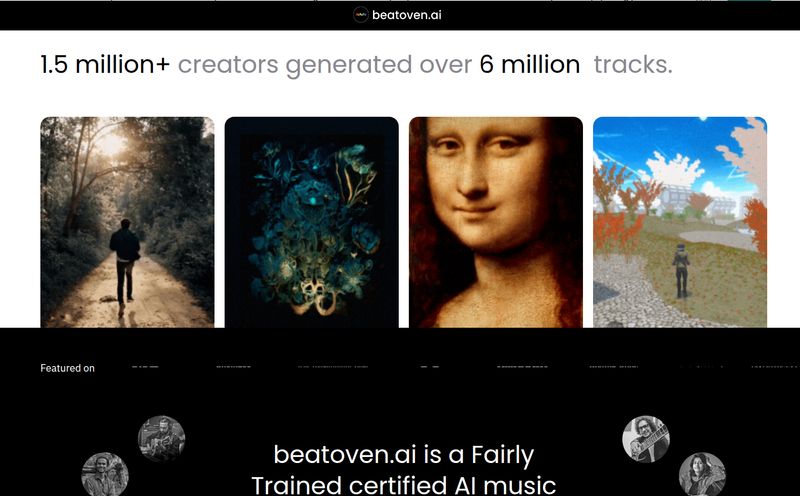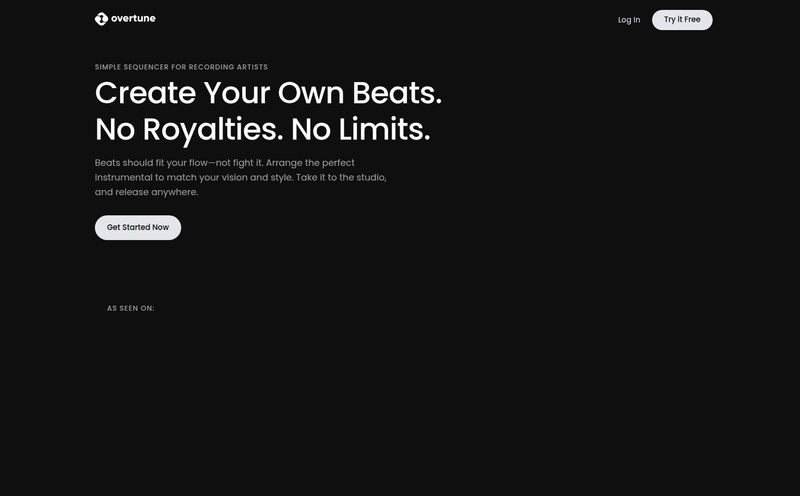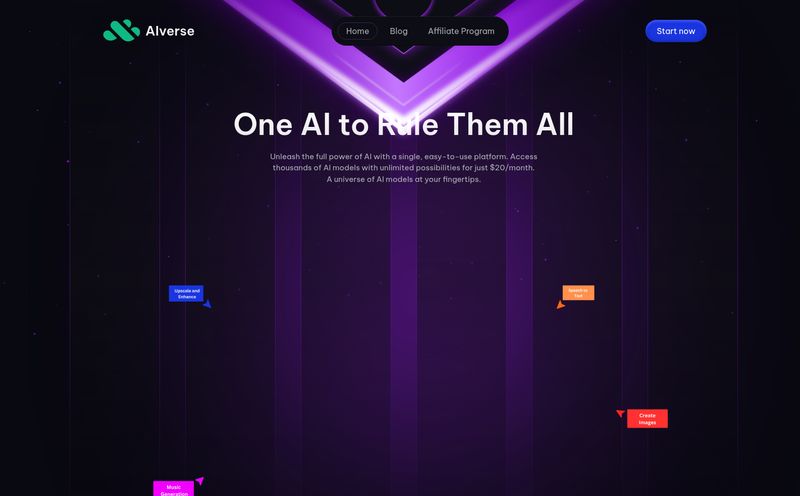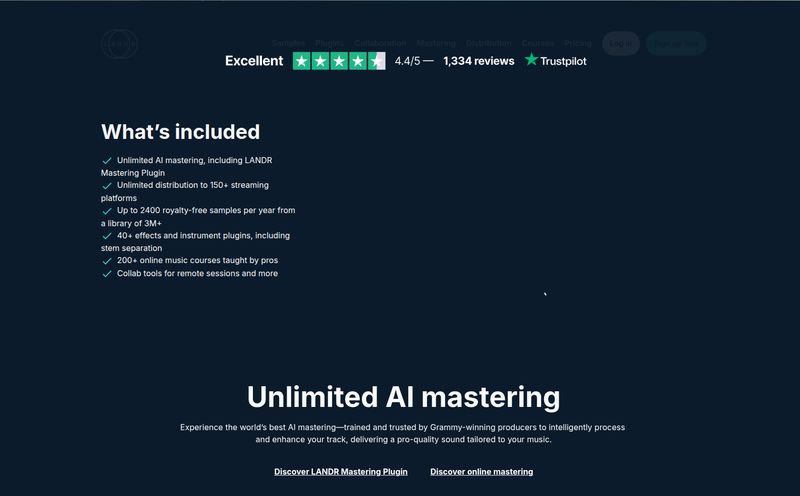For the last couple of years, my feeds and conversations have been absolutely dominated by generative AI. First, it was the writers sweating over GPT. Then, the artists got sideswiped by Midjourney and DALL-E. It felt like every other post was either a stunning AI-generated image or a think piece about the death of creativity. Fun times.
Now, the AI wave is crashing onto the shores of the music industry. And I’ve been watching this space like a hawk, because if there's one thing that's personal, it's music. So when tools like Riffusion started making noise, I had to plug in and see what was up. The promise is seductive, isn't it? Just type a few words—'lo-fi hip hop beat for studying,' 'epic cinematic trailer score'—and poof, a brand-new track materializes. But is it any good?
So, What Exactly is Riffusion?
At its core, Riffusion bills itself as a “generative AI instrument.” I kinda like that phrasing. It’s not trying to be a full-blown producer in a box. It’s an instrument. Think of it less as a robot that will steal a musician's job and more like a new kind of synthesizer, one that you play with words instead of keys. You give it a prompt, and it generates a riff, a beat, or a whole song idea based on your description.
The whole thing started as a project to visualize spectrograms (those cool heat-map looking images of sound) with Stable Diffusion and evolved from there. It's a nerdy origin story, which I always appreciate. It shows it was built from a place of genuine curiosity. And now, it’s a full-fledged platform for creating and, more interestingly, remixing music on the fly.
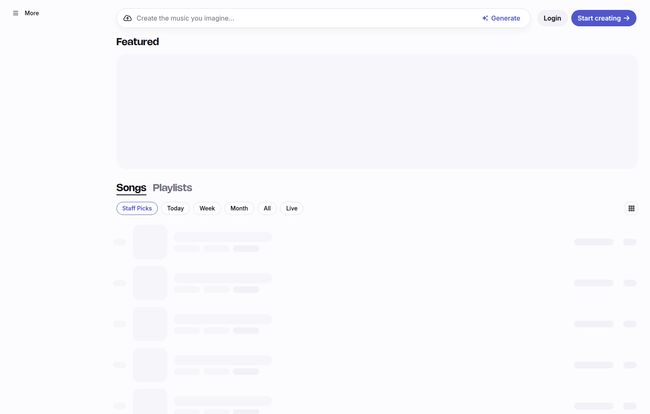
Visit Riffusion
Getting Started and First Impressions
The user interface, from what I could gather, is clean. Refreshingly simple, even. A big prompt bar at the top, a gallery of creations below. It feels very... 2024. Minimalist, intuitive, and designed to get you creating in seconds.
Now for a little real-talk. As I sat down to write this and grab some fresh examples, I navigated to their website and… BAM. Blocked. A big, fat “Sorry, you have been blocked” message from Cloudflare. I haven’t seen one of those in a while. Was it my VPN? Is the site getting so much traffic it’s having to aggressively filter? Who knows. It's a small reminder that with these new, fast-growing platforms, you sometimes hit weird bumps in the road. The Wild West of AI, folks.
Luckily, I had my notes from previous sessions. The platform operates on two main tiers, which is the most important thing to understand.
The Two Sides of the Coin: Basic vs. Studio Mode
Riffusion splits its service into two distinct modes. First up is Basic Mode. This is the free-for-all playground. You can generate an unlimited number of tracks here without paying a dime. The catch? It’s slower. Sometimes you’ll be waiting a bit for your masterpiece to render. For someone just messing around, trying to find a cool sound for a social media post or just satisfying their curiosity, this is absolutely perfect. The barrier to entry is literally zero.
Then there's Studio Mode. This is the VIP lounge. Generations are faster, and you get access to more advanced features. But it runs on a credit system called “Studio Hours.” You get a certain number of these hours with a subscription, and each generation or advanced task chews through that time. It's a classic freemium model, designed to hook you with the free stuff and then gently nudge you toward opening your wallet for a better, faster experience. Can't fault them for it; servers aren't free.
The Features That Actually Matter
Creating a song from text is the headline act, but the real magic, in my opinion, lies in the features that let you go deeper.
Beyond Generation: Stem Swapping and Remixing
This is where Riffusion started to get my attention. It’s not just a one-and-done generator. One of its standout features is stem swapping. For the non-musicians, stems are the individual instrument tracks of a song—the drums, the bass, the vocals, the synth, etc. Riffusion lets you take a track you've generated and swap out, say, its funky bassline for a driving rock bassline from another generation. This turns it from a simple generator into a modular creation tool. It’s like musical LEGOs. You can piece together different elements to build something truly unique. This is a far more creative process than just rolling the dice on a single prompt.
Never-Ending Jams: Extending Your Tracks
Ever create a super cool 8-bar loop but have no idea how to turn it into a full song? It's a classic case of writer's block. Riffusion tackles this by allowing you to extend your creations. The AI analyzes what you've got and generates a natural-sounding continuation. You can keep doing this, building out a verse, a chorus, and a bridge until you have a complete piece. It's a fantastic tool for overcoming that initial creative inertia.
Who is This Actually For?
I see a few clear groups who could get a lot out of Riffusion.
- Content Creators & Marketers: Need a unique, royalty-free track for your next YouTube video, podcast intro, or Instagram Reel? This is a goldmine. In minutes, you can have custom-made background music that no one else has, saving you from the endless scroll through stock music libraries like Epidemic Sound or Artlist.
- Musicians & Producers: Before you cry foul, hear me out. I don't see this replacing producers. I see it as a powerful new tool in their arsenal. Stuck for a melody? Generate a few ideas. Need a drum pattern to get you started? Prompt it. It's a creative co-pilot, a digital muse for breaking through those frustrating creative blocks.
- The Curious Hobbyist: If you've always wanted to make music but felt intimidated by complex software like Ableton or Logic Pro, this is your door in. It's fun, it's immediate, and it lets you experience the joy of creation without a steep learning curve.
Let's Talk Money: The Riffusion Pricing Situation
So, how much does it cost? The best answer is: it's free to start. And the free tier is generous. Unlimited generations in Basic Mode is a huge win and makes it accessible to everyone.
The paid side of things revolves around the previously mentioned Studio Hours. At the time of writing this, there isn't a public pricing page that I could find (and the Cloudflare block didn't help!), which usually means you see the subscription options once you're signed in and ready to upgrade. This is pretty standard for SaaS platforms. The cost will likely depend on how many Studio Hours you want per month. For serious users, this will be an operational cost; for hobbyists, the free plan will probably be more than enough.
The Good, The Bad, and The AI-Generated
Let's boil it down. The biggest pro is the powerful, unlimited free tier. It's a fantastic way to get anyone and everyone experimenting. The ease of use and the innovative features like stem swapping and track extension make it more than just a novelty.
On the flip side, the slower processing on the free Basic mode is a trade-off you have to accept. And the dependency on limited “Studio Hours” for premium use might frustrate power users who find themselves in a creative flow state only to be stopped by a credit limit. Also, as with any AI service, the features and plans are always in flux, so what's true today might change tomorrow.
Frequently Asked Questions About Riffusion
1. Is Riffusion really free to use?
Yes, Riffusion offers a 'Basic Mode' which is completely free and allows for unlimited song generations. For faster processing and advanced features, you'll need to use 'Studio Mode', which requires a paid subscription for 'Studio Hours'.
2. What are "Studio Hours" in Riffusion?
Studio Hours are credits used in Riffusion's premium 'Studio Mode'. Each time you generate music or use an advanced feature in this mode, it consumes a certain amount of your Studio Hours. You purchase these hours through a subscription.
3. Can I use the music I create for commercial projects?
This is the million-dollar question for all AI content. The legal landscape for AI-generated art and music is still evolving. Generally, platforms have specific terms of service outlining commercial use rights. I'd strongly advise you to check Riffusion's latest Terms of Service to be certain about the licensing for your creations.
4. How does Riffusion compare to other AI music tools like Suno or Udio?
While they are all in the AI music space, they have different strengths. Tools like Suno and Udio have gained a lot of attention for creating full songs with AI-generated vocals. Riffusion's strength seems to lie more in creating instrumental tracks, riffs, and its powerful remixing capabilities, like stem swapping and track extension, making it more of a musician's or tinkerer's tool.
5. Do I need to be a musician to use Riffusion?
Absolutely not. That’s the beauty of it. Riffusion is designed for anyone to use, regardless of their musical background. If you can write a descriptive sentence, you can create music.
Final Thoughts: A New Instrument in the Orchestra
So, is Riffusion a game-changer? In many ways, yes. It's not going to put Daft Punk out of a job, but it democratizes music creation in a way we've never seen before. It's a tool that can spark an idea, finish a thought, or just provide 30 seconds of perfect background audio for a video.
The conversation shouldn't be about AI replacing artists. It should be about how artists can use AI. Riffusion feels like a solid step in that direction—a tool that invites collaboration and experimentation rather than just spitting out a finished, sterile product. It's a new instrument, and I, for one, am excited to see what people learn to play on it.
Reference and Sources
I attempted to access the primary source at Riffusion's official website, but access was denied by the site's security service, Cloudflare. All information is based on prior use and publicly available data.
For more on the rise of AI music, I recommend reading broader tech analyses, such as those found on platforms like TechCrunch, which frequently cover the evolving landscape.
